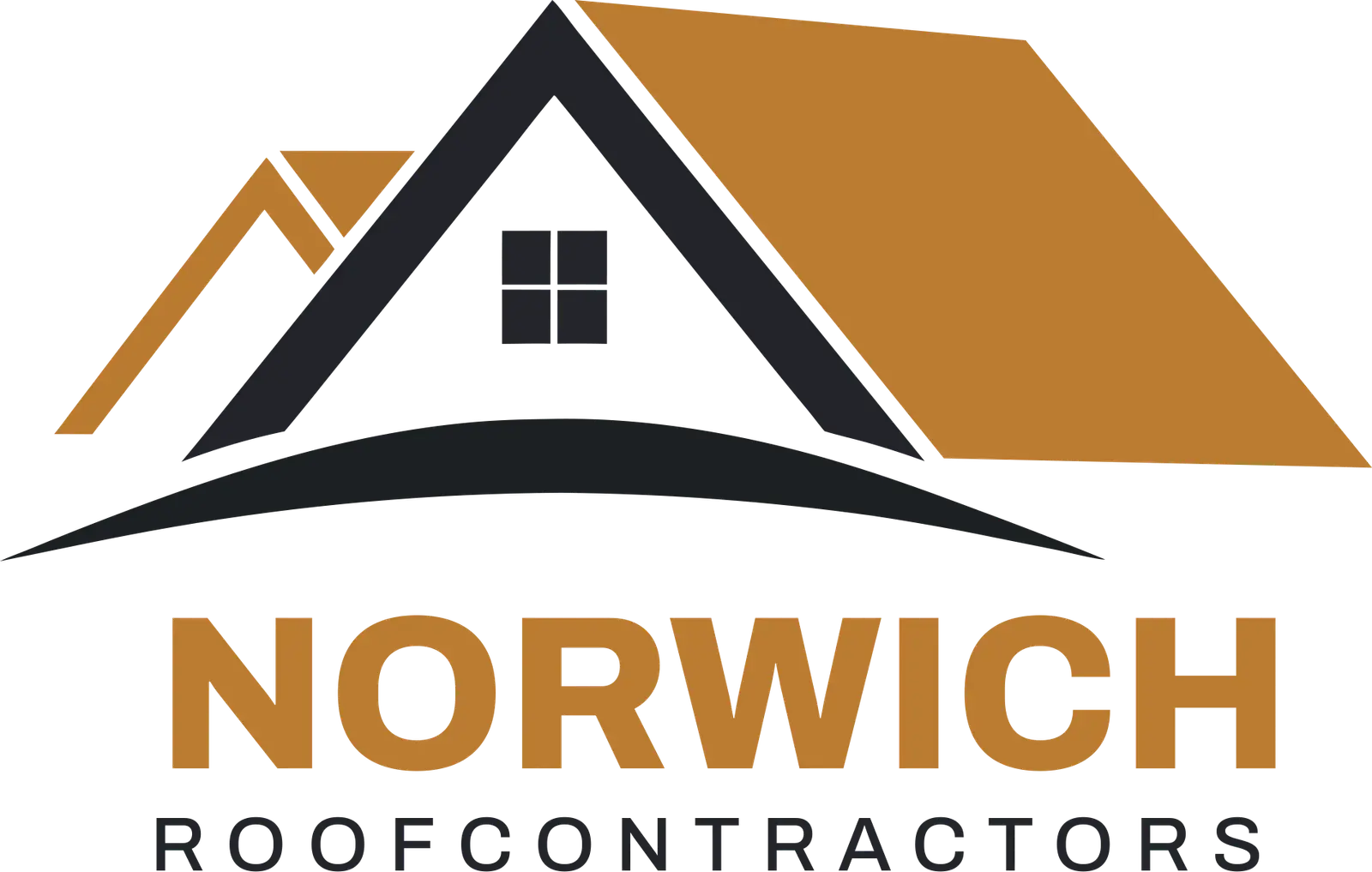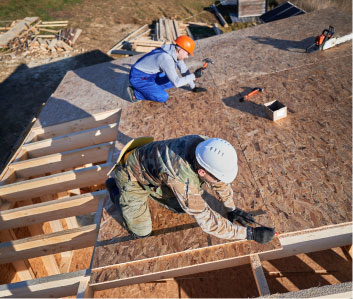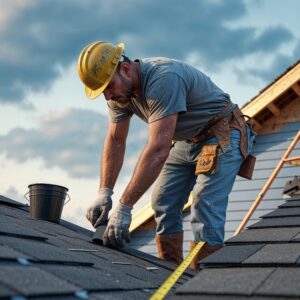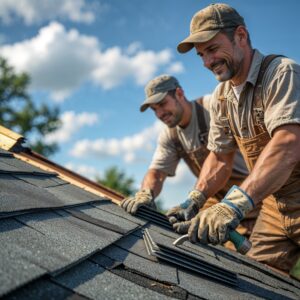Maintaining the roof of your Norwich home in good condition is essential to extend its life span. An effective roofing maintenance checklist ensures your roof withstands the region’s unpredictable weather conditions, from heavy rain to snow and saves you costly emergency repairs. It involves inspecting shingles or the attic for damage and prompt action to keep them in top condition year-round.
Common Roof Maintenance Checklist to Ensure Safety Against Norwich Weather
Evaluate your roof based on the following checklist and see what score it gets. This will help decide on the further steps.
Inspect Shingles and Attic
- Look for cracked, curled, or missing shingles.
- Check the attic for stains or damp spots indicating leaks.
- Monitor for granules in gutters (suggests shingle ageing).
Clean Gutters and Downspouts
- Remove leaves and debris from gutters.
- Secure any sagging or loose gutters.
- Clear downspout openings to ensure smooth water drainage.
Control Mould, Algae, and Lichen
- Install zinc or copper strips to deter future growth.
- Watch for algae (green/brown stains), mould (black patches), and lichen (crusty growth).
- Use fungicidal wash for minor growth; consult professionals if needed.
Check Flashing and Seals
- Re-seal any damaged or worn caulk every 3-4 years.
- Watch for water stains on ceilings indicating flashing issues.
- Inspect flashing around chimneys, valleys, and skylights for damage.
Examine Attic Insulation and Ventilation
- Seal gaps around ducts, pipes, and fixtures.
- Look for compressed or missing insulation and signs of moisture.
- Check for free air flow through intake and exhaust vents.
Fix Leaks Promptly
- Identify leaking spots using visible ceiling stains or water tests.
- Seal minor leaks immediately; consult a professional for larger repairs.
Schedule Annual Professional Inspection
- Plan inspections for spring and fall.
- Address minor issues early to prevent costly repairs.
Seasonal Roof Maintenance
Winter: Remove heavy snow, prevent ice dams, and monitor for leaks.
Spring/Summer: Clean gutters, check shingles, ensure ventilation.
Fall: Clear debris, trim overhanging trees, inspect flashing.
A well-maintained roof does more than keep the rain out. It safeguards your entire home and offers you a healthy and safe living environment. In Norwich, you experience almost every weather condition, which sometimes goes extreme but is often mild. Here, the chances of moisture buildup are high due to coastal climates, which require regular upkeep. This ultimate roof maintenance checklist covers all the necessary steps to maintain your roof’s integrity and energy efficiency every season.
Based on weather reports from 1992 to 2021, Norwich’s summers are mild with an average temperature of 18°C, but late autumn and winter bring high humidity levels of about 87%, with higher rates in the colder months of November to January.
Inspect shingles for damage or Identify any Needed Repair
Heavy winds can dislodge or curl the shingles. This can lead to leaks and moisture seeping into the walls, causing extensive damage. Look for damaged or deformed shingles, such as cracks, curls or missing pieces, after severe weather events. Inspect the interior of the attic for any staining or signs of dampness in the wall, indicating water infiltration.
If you find anything uncommon, don’t avoid it. Get immediate help from a professional to thoroughly inspect your roof. This will prevent extensive damage. Replace any missed or curled tile and seal the cracks.
If your roof has asphalt shingles, check for granules in the gutters. Granule loss indicates an ageing roof that may need replacement soon. Identifying the issues and fixing them in a timely manner is important for roof maintenance.
Clean Gutters and Downspouts for Proper Water Drainage
Clogged gutters can lead to water pooling, which can seep under the roof’s edges, mainly on flat roofs. This can happen due to debris buildup in pipelines. Water ponding on roofs can lead to severe structural damage if not managed properly.
- Remove leaves and debris from the gutters by using a garden trowel.
- Ensure you clear the downspout’s top opening as well.
- You will need a hand auger or plumbing snake for stubborn clogs, but after cleaning must check for smooth water flow.
Make sure gutters are firmly attached and can handle water drainage. Sagging gutters often indicate they need re-securing or replacing.
Check for Mould, Algae or Lichen growth to Prevent Health Issues
Your Norwich home is exposed to humidity and a damp atmosphere. These conditions are ideal for mould, algae and lichen growth, which can cause serious health hazards. Pay attention to the signs like:
- Algae typically appear as green or brown stains on the surface of the roof.
- The mould looks like fuzzy patches or black stains.
- Lichen is crusty or leafy growths that are firmly attached to the surfaces.
If you find any of the ones, use a fungicidal wash to eliminate existing minor growths. But for potential damage, consider hiring Norwich roof contractors or safe chemical removal. Clean your roof every 2-4 years to maintain living hygiene. Install zinc or copper strips along the roofline to prevent future growth, as they act as natural algae inhibitors.
Look for Flashing or Broken Sealing to Avoid Water Intrusion
Flashing is a thin layer of waterproof materials installed at possible leakage points to seal the gaps around valleys, chimneys, and skylights. Its primary purpose is to direct water away and prevent water infiltration.
- Check the attic and ceilings for any water stains that can be due to faulty flashing.
- Safely access your roof and examine all flashing points for signs of damage, rust or breaks from the roofing materials.
- Evaluate any caulk or sealant around that may need to be replaced to ensure a watertight seal.
After inspecting, prompt roof repair and maintenance are recommended to avoid further costly damages. Resealing the areas every 3 to 4 years with a high-quality roofing sealant prevents moisture from entering your Norwich home.
Examine Attic Insulation and Ventilation
Proper attic insulation is crucial for maintaining the health of your roof and overall home energy efficiency. In Norwich, where weather varies, adequate insulation maintains a consistent temperature in your home, reducing heating and cooling costs.
- Check for uneven ventilation levels or areas where it is compressed or missing. Look for signs of moisture or mould on the insulation material.
- Inspect the gaps around ducts, pipes and electrical fixtures where conditioned air may escape.
Roof refurbishment ensures that both intake and exhaust vests are present and unobstructed. When air flows freely, this contributes to energy efficiency and reduces the workload on the HVAC system. Proper ventilation means a welcoming and comfortable interior.
Fix any Roof Leaks to Prevent Further Damage
Roof maintenance starts with identifying the leaking spots and addressing them first, as this is a common source of further damage.
- Inspect visible stains on the ceiling or walls and follow them to find the leaking spot.
- If the source is not obvious, do a water test on suspected areas to observe.
- Once you find the spot, clean the surface or fill it with sealant or patching materials.
You can address the minor leaks yourself, but for major holes, there is indeed a chance to replace the shingles, which require expert assistance for proper placement.
Schedule Professional Roof Maintenance Services Yearly
An annual inspection of your Norwich home by professionals can help you find hidden defects that you must avoid. The best time for scheduling is in the spring and fall. This allows you to prepare your roof for winter and assess any damage after harsh weather.
Many roofing materials demand yearly cleaning and repair to maintain functionality and integrity. Norwich roofers thoroughly inspect all the components, outline any issues, and recommend roof repairs.
Seasonal Roof Maintenance to Reduce Norwich Climate Impacts
The roofing maintenance checklist for Norwich homes varies with seasonal changes. In summer, you should take proactive measures for UV protection and do roof repairs that require a dry atmosphere. In winter, there is an increased risk of water pooling due to heavy rain, which requires a proper drainage system.
Spring and Summer—- Inspection, Cleaning or Replacement
Use these drier and warmer months for major roof maintenance tasks like cleaning gutters and removing moss. If you are planning to schedule annual inspections or repairs, this would be the ideal time to do roof treatments. Clean downspouts thoroughly to prepare them for heavy drainage in winter.
Ensure ventilation is working properly to regulate heat temperature and create an insulating barrier for outside heat to move in. This will reduce the cost of air conditioning and keep cold inside.
Replace any missed or cracked shingles so your sealant can dry in summer easily, fixing sealing accurately.
Fall Maintenance— Trim Trees, Evaluate Flashing and Clear Debris
As autumn approaches, begin preparing your roof for Norwich’s colder months ahead. Evaluate all the flashings and gaps around vents and chimneys; if present, fix them immediately. Clear gutters from dirt, leaves, and twigs. Cut back any overhanging branches that could fall on the roof or rub against shingles during storms. Roof refurbishment in the fall season prepares for potential snow and ice accumulation.
Winter— Remove Snow, Prevent Ice Dam and Fix Leaks
Perform visual checks from the ground for any signs of ice dams or broken tiles due to harsh storms. Use a roof rake to safely remove heavy snow buildup. Avoid using sharp tools as they can exceed the damage. Keep your drainage clear to prevent ice dams from forming, which can cause water backup and leaks.
Address roof repair and maintenance by professionals on time if you observe any issue on the ceiling or attic. Your insulation system should be in good condition to prevent ice dam formation.
Conclusion:
The roof maintenance checklist for Norwich homes includes properly inspecting each part of your attic, both from the interior and exterior, for any possible issues. It helps you take timely action before the problem escalates to roof replacement. Prioritising these tasks can protect your investment, enhance your house’s curb appeal, and ensure safety against weather conditions.
FAQs
What maintenance is required for a metal roof?
Metal roofs are known for their durability and low maintenance requirements, but they can be highly susceptible to rusting in weather like Norwich. This issue needs a protective coating on your roof. Further, regular inspections should be done at least once a year to check for any dents.
What is the best thing to clean your roof with?
A mixture of water, bleach, and dish soap is effective for cleaning most roofs. This helps remove algae and stains. Apply it with a soft brush or low-pressure sprayer to avoid damaging roofing tiles. Use mild bleaching solutions that don’t contain chlorine, as they are highly corrosive.




